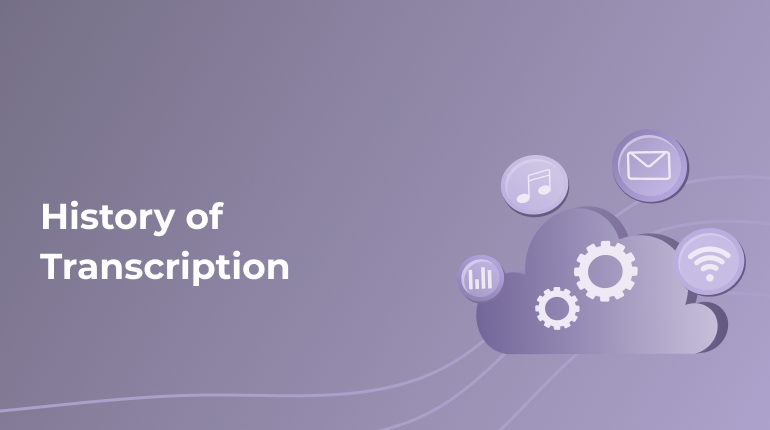A Brief History Of Transcription: From Ancient Egypt To 21st Century

If you remember anything from your high-school history course, you understand how we know exactly what happened in the era of Ancient Egypt. People covered the walls of their pyramids and tombs with hieroglyphs, and their deciphering was one of the first forms of transcription.
Thus, it can be argued that this form of documentation appeared as early as 3400 BC. Of course, it was not as widespread then as now, and scribes were in incredible demand. They attended schools, learned to read and write, practiced signs, wrote down history and laws on the orders of their kings. The training took 4-5 years. Of course, this was only the beginning; since then, humanity in general and writing, in particular, have undergone a huge number of changes.
Transcription Was a Part of Religious Knowledge
You cannot tell the story of transcription without mentioning such an important part of human history as religion.
As different religions developed in the world, scribes who preserve oral traditions became more and more popular. For example, among the Jewish population, they passed on stories to common people and government officials in order to define their people and their religious traditions.
Other countries have taken a different approach. For example, in China, soothsayers were in great demand. It was believed that they could provide answers to any questions, including supernatural ones. Since the paper had not yet been invented, soothsayers used bamboo and tortoiseshells to record their answers.
In Europe, Aristotle, Plato, and other philosophers also took care of passing on their ideas to new generations. They had their own scribes who recorded the thoughts of the sages.
Transcription in the Renaissance Times
Of course, the Renaissance was a special milestone in the history of transcription. This was a period when literacy among people was growing at a tremendous rate, and rich people were actively interested in classical works.
In addition, in 1439, the printing press was invented, which became a real revolution and allowed the mass production of texts. Oddly enough, the demand for scribes not only did not diminish but even increased. At the same time, the range of their duties also expanded; in particular, they received shorthand skills, which made the work process much faster.
Shorthand was used to record thoughts, to record parts of conversations. Famous people like Charles Dickens, Isaac Newton, Samuel Pepys, and others used shorthand to increase the speed of transcription.
Typewriters Really Changed Things at This Point
The first practical typewriter was invented in 1867 in the United States. A year later, a second model appeared. At the time, these devices were bulky and crude, but of course, they made it possible to record information much faster. When standard typewriters entered the market in 1873, they became the stenographers, constantly pressing keys.
Until that moment, only 7 women worked in the United States as stenographers, but the trend was growing, and by 1910, most of the typists were women. This contributed to the development of stenography and the gradual improvement of typewriters.
Transcription Since the 80s
Already in the 1980s, the general public gained access to computers and word processors, and this influenced significant changes. However, the method of transcribing documents remained the same and only reached the next level after the advent and spread of the Internet.
Modern people constantly deal with audio and video content and use different ways of transcribing them. However, as before, most people outsource this service because professional transcribers have the necessary knowledge, skills, and experience to provide the best result in a short time.
Voice-to-Text Transcription These Days
Regardless of industry and business size, all companies record a huge amount of content. Audio and video are used internally, for marketing purposes, for customer service, etc. It is not always about business; for example, students and their professors, journalists, scientists, psychologists, doctors, and other professionals also use the services of transcription companies. We help clients from different fields to achieve their goals.
Automated transcription vs human-generated transcription
Over the years, speech technologies have become more accurate, and today there are even special programs that can recognize speech. Each of these services has its advantages.
For example, when it comes to automated transcription, you can expect that it will provide you with a fast and cheap result. However, it is not able to replace the manual service because machines still don’t deal with the following challenges:
- to detect if there are several speakers, especially when it is a conference, negotiation, seminar, or another event with multiple speakers.
- to determine places and names of people without mistakes;
- to transcribe words that are in the different languages;
- to discern context, non-verbal communication.
When you record your own notes, or you just want to get a raw draft, and your budget is limited, an automated transcription can be a perfect choice. However, rely on human transcriptionists when:
- your audio file has some background noise;
- you need to receive the highest level of accuracy;
- your speakers have different dialects or accents;
- there are many homophones in the speeches of your speakers;
- there are several different speakers in your recording;
- you have specific requirements to be followed.
Of course, human-based transcription will take more time because even experienced specialists need at least an hour to process 15 minutes of recording. The good news is that AI technologies are constantly developing, and we’ll surely see huge progress in the next few years.
Conclusion
Right now, if you need to transcribe your video or audio files, you can always rely on our team. We’ll provide you with the best result possible!